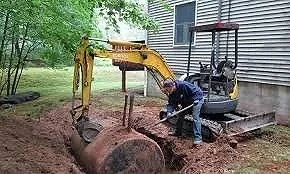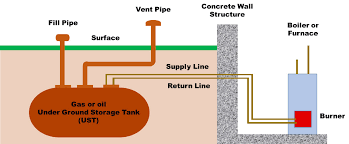What to Do When You Find an Underground Fuel Tank in North Carolina
The mystery beneath your yard
If you’ve ever bought or sold an older home in North Carolina, especially one built before the 1980s, you might stumble upon something unexpected underground: an underground fuel storage tank (aka UST), usually used for home heating oil.
While it might sound dramatic, these tanks are actually quite common across the Triad. What matters is how you handle them once discovered, because whether you remove or decommission a tank carries not only environmental and safety implications—but also legal ones.
Step 1: Understand Your Two Main Options
🟢 Decommissioning (Closure in Place)
Decommissioning means the tank stays in the ground, but it’s safely emptied, cleaned, and filled with an inert material (like sand or foam) so it can’t collapse or collect water.
Why choose it:
Less disruption to your property.
Usually more affordable than removal.
May be permitted if the tank is sound and no leaks are detected.
Legal implications:
You must document the closure method, date, and materials used.
If any leak or contamination is found, you’re legally required to report it to the NC Department of Environmental Quality (NC DEQ) immediately (NC General Statute 143-215.94E).
A tank too close to the foundation may not qualify for permanent closure in place. In that case, DEQ or your local fire marshal may require removal for safety.
You must retain closure reports for future disclosure and provide them to the next buyer.
🟣 Removal (Excavation and Disposal)
Removal means the tank is dug up, hauled off-site, and any impacted soil is tested and replaced as needed.
Why choose it:
Eliminates long-term liability.
Simplifies resale—buyers and lenders love a “clean site.”
Required if the tank has leaked, is corroded, or is within a regulated distance of the home or water source.
Legal implications:
Excavation and disposal must follow NC DEQ’s Underground Storage Tank Rules (15A NCAC 2N).
Any contaminated soil must be tested and, if necessary, remediated or disposed of at a licensed facility.
A certified environmental contractor should provide a final “No Further Action” letter or cleanup report.
Failure to report or remediate a leaking tank can result in penalties and potential future liability under NC environmental law.
Step 2: What Buyers Should Do if a Tank Is Being Decommissioned
If you’re under contract for a home where the seller is decommissioning a tank because it’s too close to the house, here’s what you need to know:
Request all permits and inspection records.
The contractor should have obtained a local permit (often through the fire marshal or building inspections department).
Ask for photos, receipts, and the closure certificate showing the tank was properly drained, cleaned, and filled.
Ask whether a soil test was done.
Even if no leak is visible, a quick soil test can confirm whether petroleum contamination is present.
If contamination is found, DEQ must be notified before closing.
Check the proximity issue.
When a tank is too close to a foundation, NC DEQ often recommends full removal.
If it’s being left in place, confirm that the fire marshal or DEQ approved that plan—otherwise, removal might still be required later.
Negotiate a repair escrow or seller credit.
If documentation is incomplete or removal may be needed later, you can request funds be held in escrow or a credit toward future costs.
Include tank documentation in your due diligence file.
Your agent (👋 that’s me!) should attach this to your closing documents so it’s easy to pass on to your next buyer.
Step 3: Disclosure – When You Go to Sell Later
As a seller, you can check no representation but your listing agent still must disclose ALL known material facts and an UST is a material fact once it is discovered.
When you eventually sell a home that once had an underground fuel tank, even if it’s decommissioned, North Carolina law requires you to disclose it.
🔍 What the NC Residential Property and Owners’ Association Disclosure Statement asks:
“Are you aware of any underground storage tank(s) located on the property?”
“If yes, have the tank(s) been closed or removed in accordance with state and local regulations?”
You must answer honestly based on your knowledge.
If the tank was professionally decommissioned or removed, you’ll want to provide:
The closure or removal report from the contractor.
Any permits, photos, and “No Further Action” letters from NC DEQ (if applicable).
A map or sketch showing where the tank was located.
Even if the tank was filled and left in place, buyers and lenders appreciate transparency. This paperwork protects you and helps the next owner feel confident about their purchase.
Understanding Your Legal Disclosure Requirements in North Carolina
When you sell a home in North Carolina, you’re required by law (N.C.G.S. § 47E) to complete the Residential Property and Owners’ Association Disclosure Statement—better known as the RPOADS.
This is not just a formality. It’s how sellers legally notify buyers of anything that could affect the property’s safety, value, or environmental condition, including the presence of an underground storage tank (UST).
On the current RPOADS form (revised May 2024, form REC 4.22), this question appears under Section F: Environmental / Flooding, item F3:
“Is there debris (whether buried or covered), an underground storage tank, or an environmentally hazardous condition (such as contaminated soil or water or other environmental contamination) located on or which otherwise affect the property?”
☐ Yes ☐ No ☐ No Representation
🟢 If your tank has been decommissioned (abandoned in place)
Check “Yes.”
In the explanation box at the bottom of Section F, clearly describe:
The type and size of the tank (for example, “275-gallon home heating-oil tank”).
The date of closure and method used (“decommissioned in 2024 by pumping, cleaning, and filling with sand”).
The contractor name and any local permit number.
Whether soil testing was performed and the results.
Attach copies of the closure report, photos, and any DEQ or local fire-marshal approval letters.
Even if there’s no contamination, keeping these documents attached to the RPOADS helps reassure buyers and their lenders that the tank is compliant and safe.
🟣 If your tank has been removed
Check “Yes.”
Then, in the same explanation area, include:
The date of removal and who performed it.
Confirmation that the tank was inspected and disposed of properly.
A note about whether soil testing was done and if a “No Further Action” letter was issued by the NC Department of Environmental Quality (DEQ).
Attach the final removal or cleanup report—this is your proof that the site was restored and no residual contamination remains.
⚠️ Why this matters
Failing to disclose a known underground tank, even one that’s been decommissioned or removed, can expose a seller to civil liability under North Carolina’s property-disclosure laws. Brokers are also required to disclose the fact if they have knowledge of it, even if the seller marks “No Representation.”
By documenting the tank’s closure or removal and providing full transparency on your RPOADS, you:
Protect yourself from future claims,
Give buyers confidence in your property’s environmental safety, and
Preserve the property’s marketability and value.
🌻 Joy’s note for sellers
Think of disclosure as peace-of-mind paperwork. Buyers aren’t scared off by a properly documented decommissioning, they’re scared off by missing answers and mystery dirt. Fill out your RPOADS completely, keep every piece of supporting documentation, and hand it off like a clean report card to your next owner.
Step 4: What to Provide to the Next Buyer
When selling a home that had a decommissioned or removed tank, include:
Closure or removal certificate (from the licensed contractor or DEQ).
Any soil sampling results showing contamination—or confirmation that none was found.
Contact information for the contractor or DEQ regional office that oversaw the work.
Photos or diagrams of the site before and after.
These documents can prevent future misunderstandings and make your disclosure airtight under NC’s property laws.
Step 5: What Happens If a Leak Is Found
If a release is discovered, the property owner must:
Notify the NC DEQ UST Section immediately.
Hire an environmental consultant to assess contamination.
Clean up or remove affected soil and groundwater.
File a Notice of Residual Petroleum (NRP) if contamination remains above state standards.
This NRP becomes part of the property record (a deed restriction) until remediation is complete.
Obtain a “No Further Action” letter when DEQ confirms cleanup is sufficient.
Failing to follow these steps can result in significant fines and may prevent future property transfers.
The Joy Watson Real Estate Perspective
As someone who’s seen her fair share of “hidden history” beneath older Greensboro homes, my take is this:
🌻 Document everything. Keep every receipt, photo, and letter—forever.
🌻 Get ahead of disclosure. A tank doesn’t have to kill a sale, but hiding one will.
🌻 Don’t panic. Make a plan. A tank too close to the home can be safely removed by licensed professionals following state law.
🌻 Lean local. Choose North Carolina-based environmental contractors who know DEQ’s regional offices and reporting systems.
Quick Comparison
| Factor | Decommission (in place) | Full Removal |
|---|---|---|
| Cost | Lower (typically $1K–$3K) | Higher ($3K–$8K+) |
| Legal requirement | Allowed if no leak, stable tank | Required if leak, corrosion, or proximity risk |
| Environmental risk | Minimal if properly cleaned | Eliminated once removed |
| Disclosure required on resale | ✅ Yes | ✅ Yes |
| Documents to retain | Closure report, photos, permit | Removal report, soil test, DEQ letter |
| Buyer perception | “Okay if documented” | “Best case — clean slate” |
Final Thoughts
Finding an underground fuel tank isn’t the end of the world, it’s often part of owning an older NC home. With clear documentation, professional handling, and full disclosure, you can protect your property value and keep your conscience (and groundwater) clean.




